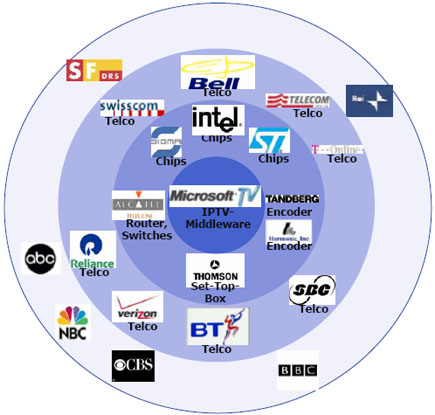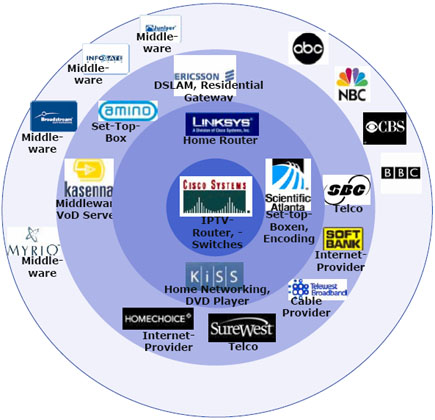 |
The following article is taken from upcoming study “Global IPTV: Learning from Industry Leaders” published by sapient and thebrainbehind (tbb). More on this comprehensive and in-depth overview of the fast growing IP-TV business segment and order forms on tbb´s studies homebase. |
“Today the boundaries between inner and outer forces of the media are confused. And our four-century preoccupation with print has fixed our attention on so limited an aspect of the media that we find it very hard to release our attention to the whole range of media influence. What I wish to show is that today we experience, in reverse, what pre-literate men faced with the advent of writing.”
When Marshal McLuhan predicted in `55 the bluring of the industries borderlines, he could only see a first sketch of what was about to begin. His assumptions and theories based on the advent of televised media and wired, instant communication finally comes to deploy it´s potential, half a century later: After years of hype, TV over the net now comes into its own. With landmark steps as Disney/ABC´s ice-breaking coorperation with iTunes, Time Warner´s “In2TV” and the BBC´s archive opening (IMP), 2005 might well find it´s entry to history as a siginificant year of media evolution. “The damn has broken”, as Intels CEO Paul Otellini stated recently. The Giants decisions to leverage the webs distribution power fully pushed the whole marketplace in an irreversible process of change.
However, those industry news are still only the peak of what we can see. Beyond the frozen surface, aside corporate media´s own newsflash there is another, even broader shift underway. Grassroot type of media and entertainment production brings the real revolution to consumers homes.
The ‘Pew Internet & American Life Project’ determined, that half of all teens in the US have created a blog or webpage, posted original artwork, photography, stories or videos online or remixed online content into their own new creations in the last year.
Terry Heaton – an US broadcast industry expert – calls this ‘the unbundled awakening’.
“This awakening of creativity among our youth — and their ability to do something with it — is the essence of what’s known as Web 2.0. We’ve moved past the early adopter stage with young people, and that will continue to flourish next year.”
The massive growth in participatory media is also shown evidently in the most recent numbers of Blogsphere´s prefered watchtool: Technocrati.



Source: http://www.sifry.com
Due to the service 50.000 posts are submitted every hour. This gives a glimpse of the potential in this field. More, the unassailable power of broadcasters in dominating eyeballs and advertising spendings is suddenly in question.
February 9th, one of the most popular vlogs, Rocketboom accomplished a thoroughly observed bidding process for ad space targeted to it´s daily viewership of 130.000. They met their planed reserve of $40.000, which equals $8000 (CPM $62). A reasonable price for up to one minute of advertising, compared to an average CPM of let´s say Channel 4´s ‘The Daily Show’ comes to round about $1050. Plus: Production costs are included in the new incumbents offerings!
It is just a question of time, that the yield management of such hand-made media becomes mature. Meanwhile for many other independent home producers it´s no longer off-limits to think about ways of capitalizing their creativity and the interest of their audience in it. Deals of pioneering Rocketboom with Tivo and Akimbo give them hope, to be able to compete with traditional media, especially in their own niche. And new startup content aggregators as Brightcove, Ourmedia or Mefeedia get a buzz, whilst they work fiercely on developing solutions to make multicast videowonderworld happen. The significance to established companies is exemplified in AOL´s/IAC´s Brightcove $16.2m engagement, which put Barry Diller in charge of the video distributer in spe. The service, which still is under development, will create a seamless flash based (and thus browser/plugin agnostic) integration to websites and has already announced a long-term partnership with Old Media´s Gem the New York Times and their lately acquired about.com site.
What we experience now is a overwhelming change in both demand and supply side, that thrive on the ‘ecosystem’ to unseen levels of complexity and dynamic evolvement. It is this reverse process McLuhan reffered to. Surely it is confusing sometimes, but in our opinion, by all complementary and network effects employed, it will result in overall growth of televised media.






